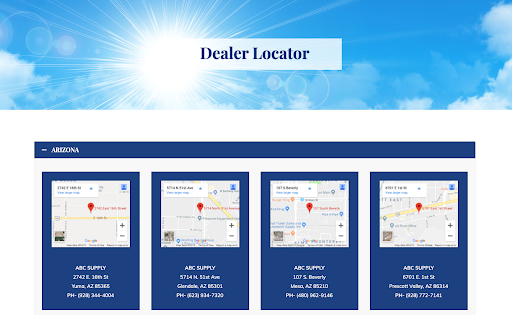
When it comes to designing your new website, there’s a whole host of things to consider. You need a design that matches your brand, a strong tone of voice with perfectly-placed calls to action and you have to dedicate hours to plotting expertly crafted copy.
There’s a strong temptation to save yourself a lot of time by compiling a list of desired features and handing over all your problems to the web developers – then closing your eyes and letting them “sort it” whilst you juggle everything else.
Due to this, for the majority of manufacturers, dealer locator pages have become an afterthought. An additional feature, rather than an essential one. Perhaps you see the practicality of their existence, but don’t necessarily have loads of time or thought to dedicate to improving yours – despite the leads, traffic, and improved conversion rates they can bring.
Whilst leaving some of the big decisions in the hands of someone else is definitely convenient for the long run, only you truly understand the value an optimized Dealer Locator page can bring to your business. Or, at least, you will soon.
Manufacturers are often left with ugly, dysfunctional dealer locator pages that don’t help them accomplish their marketing goals. They are a strongly under-utilized tool, and it’s time for that to change.
Here are some key problems traditional dealer locator pages have when they’ve been added in haste, with none of the attention to detail they require to boost your sales, improve dealer relationships, and increase your overall business success.

1. Your Dealer Locator is UGLY
Ugly dealer locator pages are ruining your audience’s first perceptions of your website, and directly helping 38% of them to click off and look for alternatives.
Dealer locator pages that haven’t been carefully designed are a threat to your goals for consistent branding and can damage the professional appearance you’ve spent so long building for your business.
You need to enhance your user experience, and that involves transforming how the software looks as well as making it easier for your users to navigate.
Heavily image-based dealer locator pages can increase loading times, and stop easy access for busy customers. Large title-text designed to draw attention to your dealer locator page could actually be hindering its ability to work – unintentionally sending away your prime customers, who might be ready with a credit card in hand.
Here’s one dealer locator page.

Not only do the hundreds of maps listed on the web page make the page slow-loading and unappealing, but the badly designed UX is lacking in functionality. Dealers are listed in alphabetical order, forcing users to scroll through hundreds of options to find the right option for them.
A Google survey shows that 53% of mobile users will switch off a webpage if it doesn’t load within 3 seconds. Your dealer locator page needs to:
- Blend in well with the rest of your webpage.
- Enhance your user experience, not ruin it.
This can be done by a simple revisit and redesign, with focus placed on the function of your dealer locator page as well as the appearance. Adding interactive buttons that allow users to request more information not only improves your lead opportunities, but is also more visually appealing and engaging. User retention times are another benefit of a brilliant dealer locator page, with Google’s algorithm scanning how long users spend interacting with your website.
2. Your Dealer Locator Doesn’t Collect Leads
Do you want to impress your dealers as well as your customers?
Did you know that some dealer locator software can track your leads and allow you to analyze key customer purchasing behavior?
If you want to know:
- How long do users spend on your dealer locator tool?
- How many options did they look at before purchasing?
- Which dealers did they decide to buy from?
Then you could benefit from smarter software running your locator pages. Being able to deliver dealers real-time evidence that you’ve sent them ‘x’ amount of sales can help improve your relationships, strengthen your negotiations, and encourage them to recommend your products over your competitors.
3. You Don’t Keep Your Dealer Information Up To Date
We know, we know – we get it.
A booming industry means you feel just as pressed for time as your customers do. Traditionally, keeping dealer locator pages up-to-date alongside your contact information meant a whole list of extra work for you, or your staff.
Not anymore.
Bullseye Location Software, a brilliant alternative for rushed web-developer programmed dealer locator pages, actually designs functionality with its users, and your requirements, in mind.
In fact, its software allows multi-channel, cross-platform data management – allowing you to spend less time crying about the work you have to do, and more time increasing the value you offer on your website.
After all, keeping key critical information up-to-date plays a huge part in actually allowing your customers to connect with their local dealers, and improving your dealer locator pages will only assist in scoring that ideal conversion rate you’ve been dreaming of.
4. Your Dealer Locator Lacks Modern Functionality That Users Now Expect
NEWSFLASH: The world is changing.
Over 75% of consumers are shopping at least once a month online. This means there are new expectations in the market: a seamless, stress-free shopping experience that allows customers to go from point A to point B with no slow-loading, complicated-user-interface hiccups.
This means your dealer locator pages need to be perfect, with zero room for mistakes. You need to:
1). Provide Accurate Stock Availability
Customers hate being sent on a “wild-goose” chase. There’s nothing worse than providing them with dealer options that have no stock of the products they want. It’s vital for you, as the dealer locator page provider, to eliminate the risk of frustration by providing accurate stock availability right from the get-go.
2). Have a Flawless User Interface
As mentioned earlier, customers are likely to click off a website if they are struggling to use it. Because of this, you need to keep your dealer locator page relevant to the latest technological advancements, and especially make sure it can be used by mobile browsers (which make up 54.8% of all internet traffic).
3). Utilize Geolocation Data
Geolocation data is one example of newer technological advancements, with internet cookies allowing websites to track where their users are browsing from. It’s a great tool that allows you as the manufacturer to speed up the buying process for your customers, which is especially great for users like architects who are always sparse in time. By programming the dealer locator page to respond automatically and reveal to customers where their local dealers are, you get to add value right from the start of their journey.
4). Program Customizable Internal Search Bars
Internal search bars allow users to customize their own experience – which they love. It will help them navigate your website, find the products they want, find the local dealers that sell them, and then make their purchases. Plus, it’s now an expectation that customers should be able to personalize their shopping journey when using a website.
The easier you can make it for your customer to make their final purchase, the better.
The likelihood is, if they’ve been looking for products on your website and are then looking at local dealers – they are ready to buy. They’ve moved through the customer decision process and are ready to be connected with the means to finalize their purchase as soon as possible.
It’s your job to make this happen.
5. Your Dealer Locator Doesn’t Make Use of Local SEO
It’s a lesser-known secret in our industry that dealer locator pages are brilliant tools for SEO, as well as general marketing.
How?
Through solving customer problems.
Say, for example, you are a customer wanting to purchase “Quartz Countertops, Atlanta”.
You head to Google and type in your search. A dealer locator page that is optimized for local SEO can point you directly towards the solution to your query (in this case, a manufacturer’s website with local dealer information), allowing you to purchase what you need.
Currently, the majority of dealer locator pages aren’t optimized for SEO.
Whether this is due to outdated software, or because you gave your web developer control rather than purchasing one specific to your needs, take a moment to imagine an impressive increase in website traffic, and the benefits new, organic leads could bring to your manufacturing company.
Yes, free leads! It’s a no-brainer.
Imagine being connected to high-intent customers rather than website browsers.
Local SEO can bring relevant traffic to help your website appear in more Google searches, and also help your SERP ranking – allowing you to present yourself as the authentic, professional business you are and score that top spot result.
One brilliant example of a company ahead of the game is GAF, a roofing manufacturer that offers local distributor and contractor locator pages. These tools then link to optimized web pages, such as “best roofers in Denver”. This helps bring organic traffic to their website, and also links prospective customers directly to the right resources for their desired purchase.

We spoke Travis Boyle, of El Paso Artificial Grass Supply, who mentioned that he currently receives 3 – 4 leads a month from his distributor locator because it ranks so well in Google Search. If you’ve started jotting down notes and noticing the upgrades that your dealer locator software is in desperate need of, pause for a moment.
There is an Easy Solution
If you’ve started jotting down notes and noticing the upgrades that your dealer locator software is in desperate need of, pause for a moment.
There’s an easier solution.
Bullseye Store Location Software actually ticks all of the boxes we’ve covered today.
Bullseye allows you to utilize SEO, track geolocation data, and stay on top of contact information with brilliant data management capabilities. We’d recommend saving yourself the job of reaching out to your web developer (who doesn’t necessarily specialize in optimizing dealer locators), and instead, try out an expert demo perfectly designed for your needs.




Leave a Reply
You must be logged in to post a comment.